Galatasaray S.K.
Galatasaray Spor Kulübü (Turkish pronunciation: [ɡaɫatasaˈɾaj ˈspoɾ kulyˈby], Galatasaray Sports Club) is a Turkish sports club based on the European side of the city of Istanbul in Turkey. Most notable for its association football department, the club also consists of various other departments including basketball, wheelchair basketball, volleyball, water polo, handball, athletics, swimming, rowing, sailing, judo, bridge, motorsport, equestrian,[7][8] and chess.[9][10] Galatasaray S.K. is among the key members of the Galatasaray Community Cooperation Committee together with Galatasaray University and the prestigious Lycée de Galatasaray.
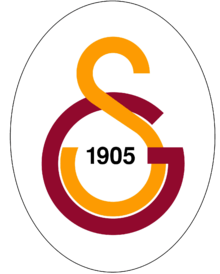 | |
| Full name | Galatasaray Spor Kulübü |
|---|---|
| Nicknames | Cimbom (Turkish pronunciation: [dʒimbom]) Aslanlar (The Lions) Gala (referred to by non-Turkish nationals) |
| Founded | 30 October 1905[1][2][3][4][5] as Galata-Serai Football Club[6] Galatasaray, Galata, Beyoğlu, Istanbul, Turkey |
| Based in | Istanbul |
| Colors | Red and yellow |
| President | Mustafa Cengiz |
| Titles | European titles: 15 |
| Website | http://www.galatasaray.org/ |
| Active departments of Galatasaray | ||||||||||||||||||||||||||||||||||||
|---|---|---|---|---|---|---|---|---|---|---|---|---|---|---|---|---|---|---|---|---|---|---|---|---|---|---|---|---|---|---|---|---|---|---|---|---|
|
The football team of the club is the only European cup winner team in Turkey, holding the most Turkish League Cups, Turkish Super Cups as well as Turkish Cups.[11][12] Galatasaray won the UEFA Cup against Arsenal F.C. and the UEFA Super Cup against Real Madrid C.F. both in 2000.
The club's wheelchair basketball team won the Champions Cup in 2008, 2009, 2011, 2013 and 2014. They also won the Kitakyushu Champions Cup and became world champions in 2008, 2009, 2011, and 2012.[13][14] Galatasaray women's basketball team won the 2013–14 EuroLeague Women and FIBA Eurocup in 2009 and 2018.[15] Galatasaray men's basketball team claimed their first EuroCup championship after defeating Strasbourg in 2016.[16]
Name
The name Galatasaray comes from that of Galatasaray High School, which in turn takes its name from Galata Sarayı Enderûn-u Hümâyûn (Galata Palace Imperial School), the name of the original school founded on the site in 1481. This takes its name from the nearby medieval Genoese citadel of Galata. Galatasaray translates directly as "Galata Palace" (Saray, Palace in Persian).[17]
History
Galatasaray SK was founded in October 1905 (the exact day is disputed, but is traditionally accepted as "17 Teşrinievvel 1321[3]" according to the Islamic Rumi calendar, which corresponds to 30 October 1905 (according to the Gregorian calendar) by Ali Sami Yen and other students of Lycée de Galatasaray (a high school in Istanbul which was established in 1481) as a football club. Ali Sami Yen, who became Galatasaray SK's first president and was given the club's membership number "1", was the son of Şemseddin Sami (Frashëri), an Ottoman writer, philosopher and playwright of ethnic Albanian origin, and a prominent figure of the Rilindja Kombëtare, the National Renaissance movement of Albania.[18]
The club's first match was against Cadi Keuy FRC and Galatasaray won this game with a score of 2–0.[19] There were discussions about the club's name, in which some suggested Gloria (victory) and others Audace (courage), but it was decided that its name would be Galatasaray.[20]
According to researcher Cem Atabeyoğlu, Galatasaray took its name from one of its first matches. In that match, Galatasaray won 2–0 over Rûm club and the spectators called them "Galata Sarayı Efendileri" (in English: Gentlemen of Galata (City) Palace), and, after this event, they adopted that name and started to call their club "GalataSaray". In 1905, during the era of the Ottoman Empire, there were no laws for associations so the club could not be registered officially, but after the 1912 Law of Association, the club registered legally.[21]
Our aim is to play together, to have a color and a name and to beat non-Turkish teams.
Along with the founder Ali Sami Yen, the co-founders were the ones who were keen to do this sport, such as Asim Tevfik Sonumut, Reşat Şirvani, Cevdet Kalpakçıoğlu, Abidin Daver and Kamil.[17]
At first, the colors of the Galatasaray Sports Club were red and white, which are the colors in the Turkish flag. However, the Turkish Republic was not founded at that time. Therefore, this inspiration caused repressive administration of the day feel uncomfortable and the administration hounded the footballers. For this reason, the colors were changed to yellow and dark blue till 1907. In 1908, new colors were chosen as red and yellow. Ali Sami Yen stated, "We were imagining brightness of yellow – red fire over our team and thinking that it would carry us from one victory to another."[21]
While the football in Turkey began to fully develop, Galatasaray won ten more Istanbul League titles until 1952. Upon recognition of professional football in 1952, the first professional but non-national league of Turkey, Istanbul Professional League played between 1952 and 1959. Galatasaray won three of these seven titles.
Turkcell Super League, the top-flight professional league in Turkish nationwide football, and the most popular sporting competition in the country, formed in 1959. Galatasaray joined all seasons and won 22 league titles since then.[22]
The Turkish Football Federation started to organize "Turkish Cup" (today it is organized with the name Ziraat Turkish Cup) in the 1962–63 season for Turkish clubs to qualify for the UEFA competitions. This is the only national cup competition in Turkey. Galatasaray joined all seasons and won 18 trophies since then.[23]
European competitions
Crest

Galatasaray's first emblem was a figure of a spread-winged eagle with a football in its beak, drawn by 333 (Galatasaray High School student number) Şevki Ege. This was replaced in 1925 by the current "Ghayn-Sin" crest, designed by Ayetullah Emin.[24]
Team colours and kit
Galatasaray wore red and white colours when founded, then played in yellow and black during the 1907–1908 season.
For a match against the football team of the Royal Navy cruiser HMS Barham, played on 8 December 1908, Galatasaray finally settled on playing in red and yellow.
Ali Sami Yen, the main founder of Galatasaray, wrote the following in his diaries:
“Our goalkeeper Asım Tevfik, left-forwarder Emin Bülent and right midfielder Ali Sami Yen were commissioned for the task of determining the new team colours. After we had been in and out of several shops, we saw two different elegant-looking wool materials in Fat Yanko's store at Bahçekapısı (between Eminönü and Sirkeci in Istanbul, now called Bahçekapı). One of them was quite dark red, resembling the cherry colour, and the other a rich yellow with a touch of orange. When the sales clerk made the two fabrics fly together with a twist of his hand they became so bright that it reminded us of the beauty of a goldfinch. We thought we were looking at the colours flickering in burning fire. We were picturing the yellow-red flames shining on our team and dreaming that it would take us to victories. Indeed it did."
The red and yellow colours were also inspired from the roses which Gül Baba offered to Sultan Bayezid II.[25]
Departments
| Sport | Teams |
|---|---|
| Football | Galatasaray S.K. (football) |
| Basketball | Galatasaray S.K. (men's basketball) |
| Galatasaray S.K. (women's basketball) | |
| Wheelchair Basketball | Galatasaray S.K. (wheelchair basketball) |
| Volleyball | Galatasaray S.K. (men's volleyball) |
| Galatasaray S.K. (women's volleyball) | |
| Water Polo | Galatasaray S.K. (men's water polo) |
| Galatasaray S.K. (women's water polo) | |
| Athletics | Galatasaray S.K. (athletics) |
| Swimming | Galatasaray S.K. (swimming) |
| Rowing | Galatasaray S.K. (rowing) |
| Sailing | Galatasaray S.K. (sailing) |
| Judo | Galatasaray S.K. (judo) |
| Bridge | Galatasaray S.K. (bridge) |
| Equestrian | Galatasaray S.K. (equestrian)[8] |
| Chess | Galatasaray S.K. (chess)[10] |
| Gymnastics | Galatasaray S.K. (gymnastics)[26] |
| Tennis | Galatasaray S.K. (tennis team; to be opened soon)[27] |
Defunct departments
- Wrestling 1887
- İstanbul Championship: Winner(8) 1945 to 1955
- Turkish Championship: Winner(2)
- Cycling 1898
- Boxing 1904 the first club in Turkey.
The first boxer in Turkey was Sabri Mahir.
- Swedish Gymnastics 1908
- Hockey 1911
- Field Hockey 1915
- Baseball 1925
- Table Tennis 1925
- Handball 1926
- İstanbul Championship: Winner(8) 1945 to 1955
- Turkish Championship: Winner(2)
- Cricket 1926
- Aviation & Gliding 1931
- Skiing & Mountaineering 1931
- Motocross 1931
- Fencing 1931
- Water ballet 1995
- Superleague Formula 2008
Reactivated departments
- Tennis 1910
- Gymnastics 1868
Stadium
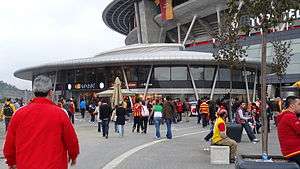
Galatasaray played during its first years in different fields, since there were not any stadiums in Istanbul. In 1921, the first stadium, Taksim Stadium opened.[28] Galatasaray played there until 1940. When the historic Taksim Stadium was demolished, Galatasaray decided to build a large, modern stadium. Due to difficulties stemming from World War II, construction was delayed for over two decades. In this period, they played in İnönü Stadium.
On 20 December 1964, Ali Sami Yen Stadium opened.[29] It was named after the founder of the club, Ali Sami Yen and was in the Mecidiyeköy quarter of the Şişli district at the center of the city. In 1964, the stadium had a capacity of over 35,000. Due to improvements in security and prohibition of standing spectators, it had an all-seater capacity of 24,990 and was nicknamed "Hell".[30]
After 2002, when Atatürk Olympic Stadium was built for Istanbul's Olympic Games bid, Galatasaray started to play European Cup matches there. The attendance record for a Turkish stadium was broken there, in a Galatasaray–Olympiacos match played in front of 79,414 spectators. But the Ali Sami Yen Stadium had historic importance for Galatasaray fans although it was smaller and older.[31]
The new Türk Telekom Stadium was built for Galatasaray in return for the highly valued land of the historic Ali Sami Yen stadium in Mecidiyekoy, and became the new home ground for Galatasaray S.K., replacing the old Ali Sami Yen Stadium. The new stadium has a capacity of 52,695 seats. The Ali Sami Yen Stadium was demolished in 2011 with the contractor revealing that it was on the verge of collapse and that a major stadium disaster would almost certainly have occurred had the stadium remained in use[32]
Since 1998, after every goal scored by Galatasaray, the last part of the song "I Will Survive" by the Hermes House Band is played. Although the song is in English and already adopted by Dutch football team Feyenoord, the part used has no lyrics except "la la la la". This makes it easy for fans to participate.
In addition, before every game the Florida State Seminoles' war chant is played accompanied by what the fans call a "scarf show", where fans display and wave their Galatasaray scarves.[33]
Other facilities
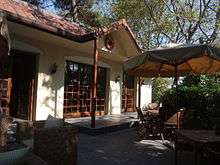
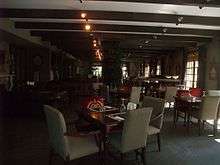
- Galatasaray Islet
- Galatasaray Museum
- Florya Metin Oktay Sports Complex and Training Center
- Galatasaray Beyoğlu Hasnun Galip Club Administrative Center
- Galatasaray Kalamış Sailing Facilities
- Galatasaray Küçükçekmece Rowing Center
- Galatasaray Nevzat Özgörkey Equestrian Facilities[34]
- Galatasaray Olympic Aquatic Center[35]
- Galatasaray Gölbaşı Ankara Facilities[36]
- Galatasaray Taçspor Tesisleri[37]
Club officials
- Board of directors
| Office | Name |
|---|---|
| President | Mustafa Cengiz |
| Deputy President | Abdurrahim Albayrak |
| Vice President | Mehmet İpekdokuyan |
| Board secretary | İsmail Sarıkaya |
| Treasurer | Mete İkiz |
- Presidents
| From-to | Names |
|---|---|
| 1905–1918 | Ali Sami Yen |
| 1990–1996 | Alp Yalman |
| 1996–2001 | Faruk Süren |
| 2001–2002 | Mehmet Cansun |
| 2002–2008 | Özhan Canaydın |
| 2008–2011 | Adnan Polat |
| 2011–2014 | Ünal Aysal |
| 2014–2015 | Duygun Yarsuvat |
| 2015–2018 | Dursun Özbek |
| 2018– | Mustafa Cengiz |
Other businesses
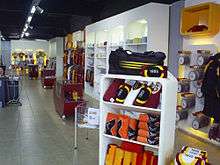
Galatasaray AŞ owns a chain of shops (total 81), Galatasaray Store, selling club merchandise in Turkey, Azerbaijan, Netherlands, Germany, and Northern Cyprus. The club also owns an online betting company, an insurance company, an Internet service provider company, a travel agency, a forex company, and a search engine company.
Footnotes
- "Tweets with replies by melih sabanoglu (@melihsabanoglu)". Twitter. Retrieved 25 January 2018.
- "Tweets with replies by melih sabanoglu (@melihsabanoglu)". Twitter. Retrieved 25 January 2018.
- "Tweets with replies by melih sabanoglu (@melihsabanoglu)". Twitter. Retrieved 25 January 2018.
- "Galatasaray Nasıl Kuruldu". galatasaray.org.
- "İlk Yıllar". Samir.Agayev.
- "Binicilik Ana Sayfa - GALATASARAY.ORG". Galatasaray.org. Retrieved 25 January 2018.
- "Binicilik Ana Sayfa". galatasaray.org.
- "Satranç Ana Sayfa - GALATASARAY.ORG". Galatasaray.org. Retrieved 25 January 2018.
- "Satranç Ana Sayfa". galatasaray.org.
- "Türkiye Kupası Tarihçe ve Arşiv TFF". TFF.org. Retrieved 25 January 2018.
- "Turkish Soccer – Türkiye Spor Yazarları Derneği Kupası". Angelfire.com. Retrieved 25 January 2018.
- "GALATASARAY.ORG". Galatasaray.org. Retrieved 25 January 2018.
- "GALATASARAY.ORG". Galatasaray.org. Retrieved 25 January 2018.
- "GALATASARAY.ORG". Galatasaray.org. Retrieved 25 January 2018.
- "Galatasaray Odeabank Istanbul vs. Strasbourg – Game – Welcome to 7DAYS EuroCup". EurocupBasketball.com. Retrieved 25 January 2018.
- "GALATASARAY.ORG". Galatasaray.org. Retrieved 25 January 2018.
- Bozkurt Güvenç, Türk Kimliği, Kültür Bakanlığı, 1993, p. 32. (in Turkish)
- "First match and foundation". Galatasaray.org. 17 November 2007. Archived from the original on 10 April 2008.
- "How Galatasaray Founded". Galatasaray.org. 23 November 2007. Archived from the original on 9 May 2008.
- "History of founding from official site". Galatasaray.org. 22 November 2007.
- "Türkiye Profesyonel 1. Ligi". Galatasaray.org. 21 November 2007.
- "Information about Turkish Cup". Tff.org. 20 November 2007.
- http://www.galatasaray.org/tarih/pages/tarihlogo.php
- "Yellow Red since 100 Years". GALATASARAY.ORG.
- "Cimnastik Okulları". GALATASARAY.ORG.
- "Olağan Genel Kurul Yapıldı". GALATASARAY.ORG.
- "En Eski Stadı". İstanbul'un Enleri. 16 September 2007. Archived from the original on 22 December 2008.
- "Ali Sami Yen Stadium". Archived from the original on 9 June 2007. Retrieved 26 November 2007.
- "Ali Sami Yen Stadium Information". The Stadium Guide. Retrieved 26 November 2007.
- "Zulümpiyat! Stadı". Fotomaç. 20 October 2006. Retrieved 15 July 2007.
- http://www.stadiumguide.com/alisamiyen/ Ali Sami Yen which is popular president of Galatasaray – The Stadium guide
- ultrAslanForce (1 March 2007). "Fener Maçı öncesi Muhteşem Atkı Show!!". Retrieved 25 January 2018 – via YouTube.
- "Nevzat Özgörkey Binicilik Tesisleri - GALATASARAY.ORG". Galatasaray.org. Retrieved 25 January 2018.
- "Ergun Gürsoy Olimpik Yüzme Havuzu - GALATASARAY.ORG". Galatasaray.org. Retrieved 25 January 2018.
- "Galatasaray Gölbaşı Ankara Facilities". Galatasaraylilarbirligi.org.tr. Retrieved 25 January 2018.
- "Taç Spor Tesisleri - GALATASARAY.ORG". Galatasaray.org. Retrieved 25 January 2018.
References
- Birand, M. A., & Polat, M. M. (2006). Passion that continues for 100 years. İstanbul: D Yapım. OCLC 164788939
- Turagay, U., Özgün, G., Gökçin, B., Ahunbay (2006). 17 May: The story of a championship. İstanbul: D Yapım. OCLC 169899400
- Hasol, D. (2004). Dreams/realities in Galatasaray. İstanbul: Yapı Yayın. ISBN 975-8599-44-5
- Tuncay, B. (2003). Galatasaray with European Success and Notable Players. Yapı Kredi Kü̈ltü̈r Sanat Yayıncılık. ISBN 978-975-08-0427-4
- Yamak, O. (2001). Galatasaray: Story of 95 years. Sinerji. OCLC 59287768
- Çakır, A. (1995). 90 questions about history of Galatasaray SK. Cağaloğlu, İstanbul: Demir Ajans Yayınları. OCLC 42434622
- Tekil, S. (1986). History of Galatasaray, 1905–1985. Galatasaray Spor Kulübü. OCLC 25025508
- Tekil, S. (1983). Galatasaray 1905–1982: Memories. Arset Matbaacılık Koll. Şti. OCLC 62614035
- İsfendiyar, F. (1952). History of Galatasaray. İstanbul: [Doğan Kardeş yayınları]. OCLC 27753643
External links
| Wikimedia Commons has media related to Galatasaray S.K.. |
- (in Turkish and French) Galatasaray Sports Club Official Website